Newsletter January 2023
In the Art world, there is plenty to look forward to in 2023!
Two centenary’s that have caught my eye are Sorolla, ‘Spain’s master of light’ and the ‘Divine Sarah’, the greatest tragic actress of her age. Both died in 1923. Both centenaries will be marked with exhibitions in Madrid, Valencia and Paris. I have three lectures on Sorolla on open access…go to Anne Anderson Art and Design History Channel.
To mark Sarah Bernhardt’s centenary, the Petit Palais, Paris will be holding an exceptional exhibition from 14th April to 27th August 2023. With over 400 hundred exhibits ranging from costumes to paintings and photographs the exhibition will cover her amazing career as an actress and artist. To whet your appetite, I will be offering a one-hour lecture on the ‘Divine Sarah’ which will cover not only her stage career but also her complicated love life (she was bisexual) and success as a sculptor. It will pay special attention to the intersection of her career with that of Oscar Wilde. The two had much in common!
Please join me on Wednesday 25th January, at either 11am or 7pm BST to learn more about the ‘Divine Sarah’. For details of how to join go to the end of this blog.

‘The Divine Sarah’: Sarah Bernhardt (1844-1923), a modern celebrity
With her lyrical ‘golden voice’ and stage presence the ‘Divine Sarah’ held her audiences in thrall. As Mark Twain put it, ‘there are five kinds of actresses: bad actresses, fair actresses, good actresses, great actresses—and then there is Sarah Bernhardt.’ Artists hoped to paint her. Playwrights created roles for her.
Edmond Rostand, who described her as ‘the queen of the pose and the princess of the gesture,’ wrote La Princesse Lointaine/The Unattainable Princess (1895) to display her talents. Rene Lalique designed her dramatic head-dress of bejewelled lilies, while Alphonse Mucha’s Art Nouveau posters immortalised the role.
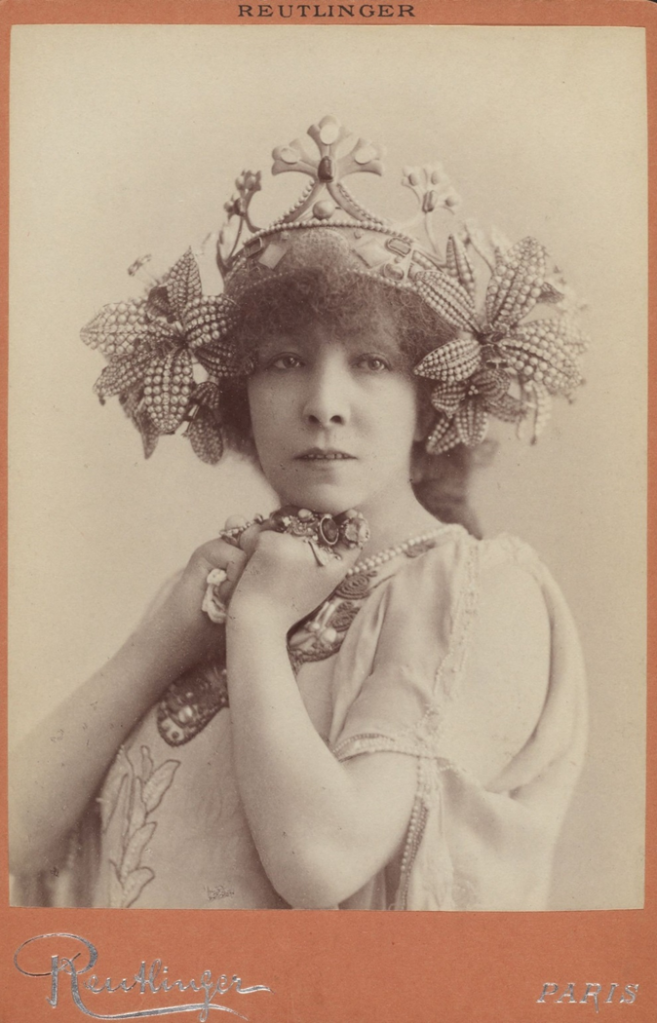
Sarah Bernhardt as Mélisande in La Princesse Lointaine wearing the headdress designed by Alphonse Mucha and created by Rene Lalique (1895).
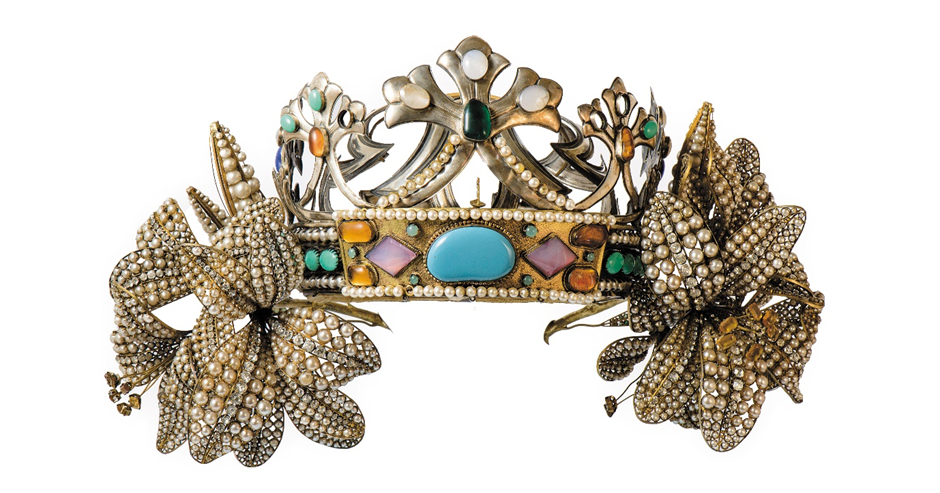

Alphonse Mucha’s poster in honour of Sarah Bernhardt
Victorien Sardou offered Bernhardt many melodramatic roles, writing Fédora (1882), Théodora (1884), La Tosca (1887) and Cléopâtre (1890) for her. Playing variously a vicious queen, a prostitute, and a lady of dubious morality, Bernhardt embodied the ‘femme-fatale’.
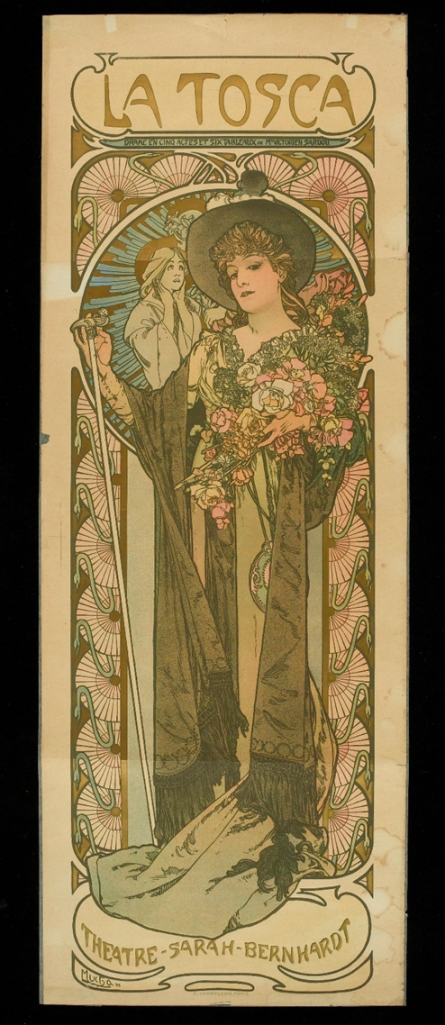
Sarah Bernhardt in the role of La Tosca. Colour lithograph by Mucha, 1899.
When Bernhardt arrived in England in May 1879, Oscar Wilde, accompanied by the actor Johnston Forbes-Robertson went down to Folkestone to greet her. Forbes-Robertson presented her with a gardenia, while Wilde, overhearing the cry ‘they’ll make a carpet of flowers for you soon’, is said to have flung down an armful of lilies. As she rather reluctantly walked over the blooms, Wilde cried out ‘Hip, hip hurrah! A cheer for Sarah Bernhardt!’ After attending her opening night at the Gaiety Theatre, Wilde heaped rapturous praise on Sarah’s performance of Racine’s Phedre.

Sarah Bernhardt in Racine’s Phèdre, Nadar, c. 1874
He declared her performance to be ‘the most splendid creation’ he had ever witnessed. Oscar ‘poured out his soul’ in a sonnet, ‘How vain and dull our common world must seem/To such a one as Thou’. He had already learnt the lesson of hitching his star to an international celebrity; his sonnet appeared in the well-read Society weekly paper The World. During Sarah’s sojourn in London, Wilde remained her ‘devoted attendant’. The actress even graced his rooms in Salisbury Street, off the Strand. After one jolly supper party, she scrawled her signature on the whitewashed panelling.
Bernhardt returned to London in 1892, the same year Oscar achieved his first West End hit with Lady Windermere’s Fan. Impressed by this achievement, Sarah asked him to write a play for her. In jest he replied he had already done so, with Salomé. A reading of the play apparently whetted her imagination. It was not ‘religious’ but rather dealt with desire- ‘love, passion, nature, the stars.’ She wanted to play the title role immediately, as part of her current London season. For Wilde this would have been an amazing coup, an artistic triumph to match the commercial success of his Society comedy.
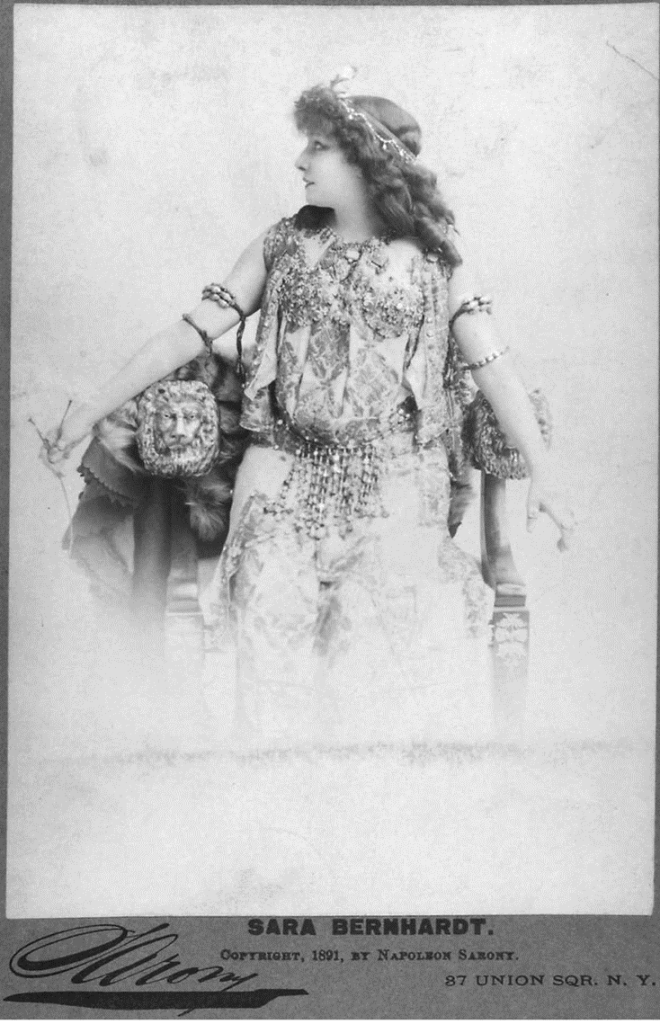
Graham Robertson designed the costumes for the original production of Salomé at the request of Bernhardt. Wilde expressed a desire that they should be in varying shades of yellow, from pale lemon to almost orange. The choice was deliberate, echoing the racy French ‘yellow- backed’ novels.
Rehearsals began at once. If Wilde harboured any doubts about a 47-year-old woman playing a young girl, they were soon dispelled. To hear his words ‘spoken by the most beautiful voice in the world’ was ‘the greatest joy that is possible to experience’. Although Wilde had grandiose plans for the stage setting and costumes, to save money the scenery and costumes for Cleopatra were to be used. However, Wilde’s ambitions were dashed when the Lord Chamberlain refused to grant a license for the play. Sarah was unwilling to give up the part, declaring ‘the role is mine, Mr Oscar Wilde has given it to me, and nobody else can perform it. No, no, no.’ But it was not to be, Wilde never saw his play produced. However, Mucha gives us a taste of what might have been!
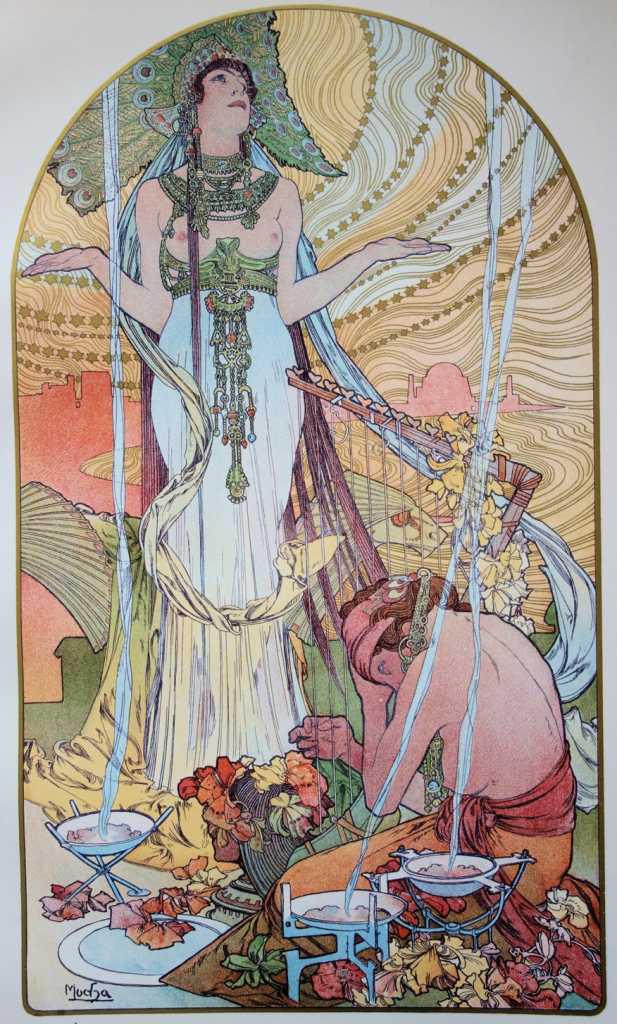
Alphonse Mucha, Salomé , coloured lithograph, 1897
Like Oscar, Sarah was a shrewd self-promoter. According to Hannah Manktelow, she ‘cultivated her image as a mysterious, exotic outsider. She claimed to sleep in a coffin and encouraged the circulation of outlandish rumours about her eccentric behaviour.’
Like Wilde she has left us some wonderful ‘bon mot’….
Oscar Wilde: ‘Do you mind if I smoke?’ Sarah Bernhardt: ‘I don’t care if you burn.’
‘It is by spending oneself that one becomes rich’
‘Slow down? Rest? With all eternity before me?’
[When asked aged 79 why her Paris apartment was on the top floor, up many flights of stairs she declared:
It’s the only way I can still make the hearts of men beat faster.
Please join me on Wednesday 25th January, at either 11am or 7pm BST to learn more about the ‘Divine Sarah’. I will be repeating the morning lecture in the evening of the same day for those people unable to make the morning slot.
The lecture will be delivered live by Zoom. It will be uploaded afterwards to my YouTube channel, and you will be provided with a private link to view it again at your leisure.
The lecture lasts for around an hour.
As the lectures will be delivered live by Zoom, you will be able to ask your questions in person at the end. You can also use the ‘Chat’ function.
The lecture costs £10. To book a place
Please email Susan Branfield at susanbranfield@waitrose.com
Or you can pay by cheque or BACS (details will be supplied). Cheques should be made payable to Anne Anderson.
Or you can pay by PayPal

One lecture
‘Divine Sarah’
£10.00
Once you register and pay, you will be sent a separate email with your link. You will need this link to access the lecture on the day so please do not delete it.
After the lecture you will be sent another private link so you can access the lecture on my YouTube Channel.
Please join me on Wednesday 25th January, at either 11am or 7pm BST
Thanks so much for these lectures!
LikeLike
Pleased you are enjoying the lectures!
LikeLike